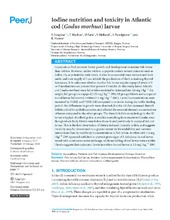| dc.contributor.author | Penglase, Samuel | |
| dc.contributor.author | Harboe, Torstein | |
| dc.contributor.author | Sæle, Øystein | |
| dc.contributor.author | Helland, Synnøve | |
| dc.contributor.author | Nordgreen, Andreas Hoel | |
| dc.contributor.author | Hamre, Kristin | |
| dc.date.accessioned | 2016-08-02T09:21:28Z | |
| dc.date.available | 2016-08-02T09:21:28Z | |
| dc.date.issued | 2013-02-19 | |
| dc.Published | PeerJ 2013, 1:e20 | eng |
| dc.identifier.issn | 2167-8359 | en_US |
| dc.identifier.uri | http://hdl.handle.net/1956/12382 | |
| dc.description.abstract | Copepods as feed promote better growth and development in marine fish larvae than rotifers. However, unlike rotifers, copepods contain several minerals such as iodine (I), at potentially toxic levels. Iodine is an essential trace element and both under and over supply of I can inhibit the production of the I containing thyroid hormones. It is unknown whether marine fish larvae require copepod levels of I or if mechanisms are present that prevent I toxicity. In this study, larval Atlantic cod (Gadus morhua) were fed rotifers enriched to intermediate (26 mg I kg-1 dry weight; MI group) or copepod (129 mg I kg-1 DW; HI group) I levels and compared to cod larvae fed control rotifers (0.6 mg I kg-1 DW). Larval I concentrations were increased by 3 (MI) and 7 (HI) fold compared to controls during the rotifer feeding period. No differences in growth were observed, but the HI diet increased thyroid follicle colloid to epithelium ratios, and affected the essential element concentrations of larvae compared to the other groups. The thyroid follicle morphology in the HI larvae is typical of colloid goitre, a condition resulting from excessive I intake, even though whole body I levels were below those found previously in copepod fed cod larvae. This is the first observation of dietary induced I toxicity in fish, and suggests I toxicity may be determined to a greater extent by bioavailability and nutrient interactions than by total body I concentrations in fish larvae. Rotifers with 0.6 mg I kg-1 DW appeared sufficient to prevent gross signs of I deficiency in cod larvae reared with continuous water exchange, while modelling of cod larvae versus rotifer I levels suggests that optimum I levels in rotifers for cod larvae is 3.5 mg I kg-1 DW. | en_US |
| dc.language.iso | eng | eng |
| dc.publisher | PeerJ | en_US |
| dc.rights | Attribution CC BY | eng |
| dc.rights.uri | http://creativecommons.org/licenses/by/3.0/ | eng |
| dc.subject | Fish larvae | eng |
| dc.subject | Cod larvae | eng |
| dc.subject | Rotifers | eng |
| dc.subject | Iodine requirement | eng |
| dc.subject | Iodine toxicity | eng |
| dc.subject | Thyroid hormones | eng |
| dc.subject | Thyroid follicles | eng |
| dc.subject | Mineral interactions | eng |
| dc.subject | Colloid goitre | eng |
| dc.title | Iodine nutrition and toxicity in Atlantic cod (Gadus morhua) larvae | en_US |
| dc.type | Peer reviewed | |
| dc.type | Journal article | |
| dc.date.updated | 2016-04-11T12:46:30Z | |
| dc.description.version | publishedVersion | en_US |
| dc.rights.holder | Copyright 2013 The Authors | en_US |
| dc.identifier.doi | https://doi.org/10.7717/peerj.20 | |
| dc.identifier.cristin | 1051429 | |
| dc.relation.project | Norges forskningsråd: 199482 | |
| dc.relation.project | EU: LARVANET – COST action FA0801 | |
| dc.relation.project | Norges forskningsråd: 185006 | |
| dc.subject.nsi | VDP::Landbruks- og fiskerifag: 900::Fiskerifag: 920::Fiskehelse : 923 | |
| dc.subject.nsi | VDP::Agriculture and fisheries science: 900::Fisheries science: 920::Fish health: 923 | |

